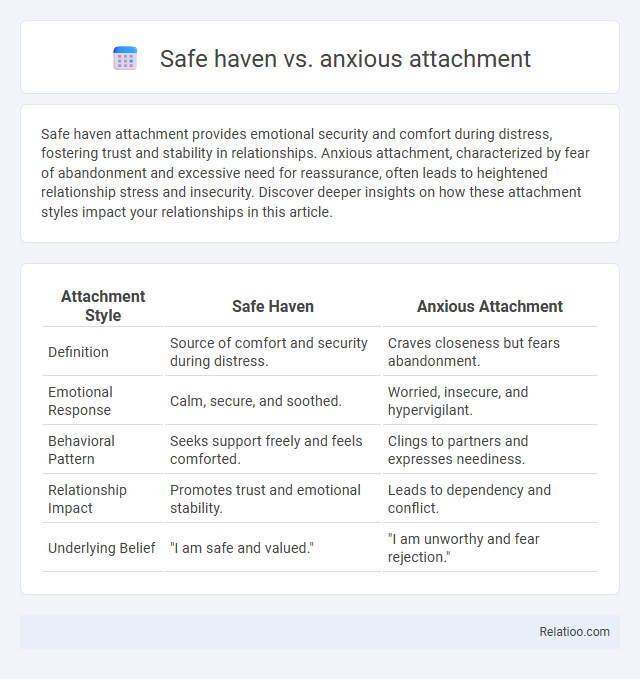Safe haven attachment provides emotional security and comfort during distress, fostering trust and stability in relationships. Anxious attachment, characterized by fear of abandonment and excessive need for reassurance, often leads to heightened relationship stress and insecurity. Discover deeper insights on how these attachment styles impact your relationships in this article.
Table of Comparison
| Attachment Style | Safe Haven | Anxious Attachment |
|---|---|---|
| Definition | Source of comfort and security during distress. | Craves closeness but fears abandonment. |
| Emotional Response | Calm, secure, and soothed. | Worried, insecure, and hypervigilant. |
| Behavioral Pattern | Seeks support freely and feels comforted. | Clings to partners and expresses neediness. |
| Relationship Impact | Promotes trust and emotional stability. | Leads to dependency and conflict. |
| Underlying Belief | "I am safe and valued." | "I am unworthy and fear rejection." |
Understanding Attachment Theory: An Overview
Safe haven, anxious attachment, and secure attachment are key concepts within Attachment Theory, which explains how early relationships with caregivers influence emotional bonds and behavior in adulthood. Safe haven refers to the caregiver's role as a comforting presence during distress, while anxious attachment is characterized by heightened need for reassurance and fear of abandonment due to inconsistent caregiving. Secure attachment develops when a safe haven is reliably available, fostering trust, emotional regulation, and healthy interpersonal connections throughout life.
What Is a Safe Haven in Attachment?
A safe haven in attachment refers to a trusted figure who provides comfort and security during times of distress, enabling emotional regulation and stress relief. Individuals with secure attachment view their safe haven as a reliable source of support, whereas those with anxious attachment often seek excessive reassurance from their safe haven due to fear of abandonment. The effectiveness of a safe haven in fostering emotional stability is crucial for healthy relationship dynamics and psychological resilience.
Characteristics of Anxious Attachment
Anxious attachment is characterized by heightened sensitivity to relationship threats, fear of abandonment, and a strong desire for closeness that often leads to clinginess or dependency. You may find yourself constantly seeking reassurance and struggling with insecurity, which contrasts with the calm confidence of a safe haven attachment. Understanding these traits helps in identifying patterns that can be addressed for healthier emotional connections.
Safe Haven vs Anxious Attachment: Key Differences
Safe haven attachment provides emotional security through consistent responsiveness, allowing individuals to seek comfort and soothe distress effectively. Anxious attachment is characterized by insecurity and fear of abandonment, leading to heightened dependency and difficulty trusting that comfort will be available. The key differences lie in the stability of emotional support and the degree of confidence in the caregiver's presence during times of stress.
Childhood Roots of Attachment Styles
Childhood experiences with primary caregivers form the foundation of attachment styles, where a safe haven arises from consistent, responsive care fostering security and trust. Anxious attachment develops when caregivers are unpredictably available, creating uncertainty and heightened sensitivity to rejection in children. These early interactions shape emotional regulation and relationship patterns throughout life, underscoring the critical role of childhood in attachment formation.
Emotional Responses in Safe Haven vs Anxious Attachment
Emotional responses in safe haven attachment involve seeking comfort and reassurance from a trusted figure during stressful times, promoting feelings of security and calmness. In contrast, anxious attachment triggers heightened emotional distress, characterized by fear of abandonment, clinginess, and hypervigilance to relationship threats. Your ability to recognize these patterns can improve emotional regulation and foster healthier interpersonal connections.
Impact on Romantic Relationships
Safe haven attachment provides Your romantic relationships with emotional security and trust, enabling effective conflict resolution and intimacy. Anxious attachment often leads to fear of abandonment and heightened sensitivity to partner behaviors, causing frequent misunderstandings and emotional turbulence. Secure attachments foster stability and mutual support, while anxious patterns can undermine relational satisfaction and long-term commitment.
Coping Strategies for Anxious Attachment
Coping strategies for anxious attachment focus on developing self-soothing techniques and building emotional regulation skills to reduce dependency on others as a safe haven. Practicing mindfulness, strengthening self-awareness, and fostering secure relationships can help individuals manage anxiety and improve their attachment security. Cognitive-behavioral approaches targeting negative thought patterns promote healthier coping mechanisms and enhance resilience in stressful situations.
Cultivating a Secure, Safe Haven Attachment
Cultivating a secure, safe haven attachment involves consistent emotional responsiveness and reliable comfort, which helps reduce anxiety and fosters trust within relationships. Unlike anxious attachments characterized by fear of abandonment and hypervigilance, safe haven bonds provide stability and reassurance, promoting healthier emotional regulation. Developing these secure connections enhances resilience and emotional well-being by establishing a dependable foundation for support during stress or distress.
Therapeutic Approaches to Healing Attachment Wounds
Therapeutic approaches to healing attachment wounds focus on addressing the core differences between safe haven and anxious attachment styles by promoting emotional regulation and secure bonding. Techniques such as Emotionally Focused Therapy (EFT) and Attachment-Based Therapy help you develop trust and safety in relationships, fostering a secure attachment that mitigates anxiety and fear of abandonment. Integrating mindfulness practices and cognitive-behavioral strategies enhances self-awareness and emotional resilience, supporting long-term healing and relational stability.

Infographic: Safe haven vs Anxious attachment
 relatioo.com
relatioo.com